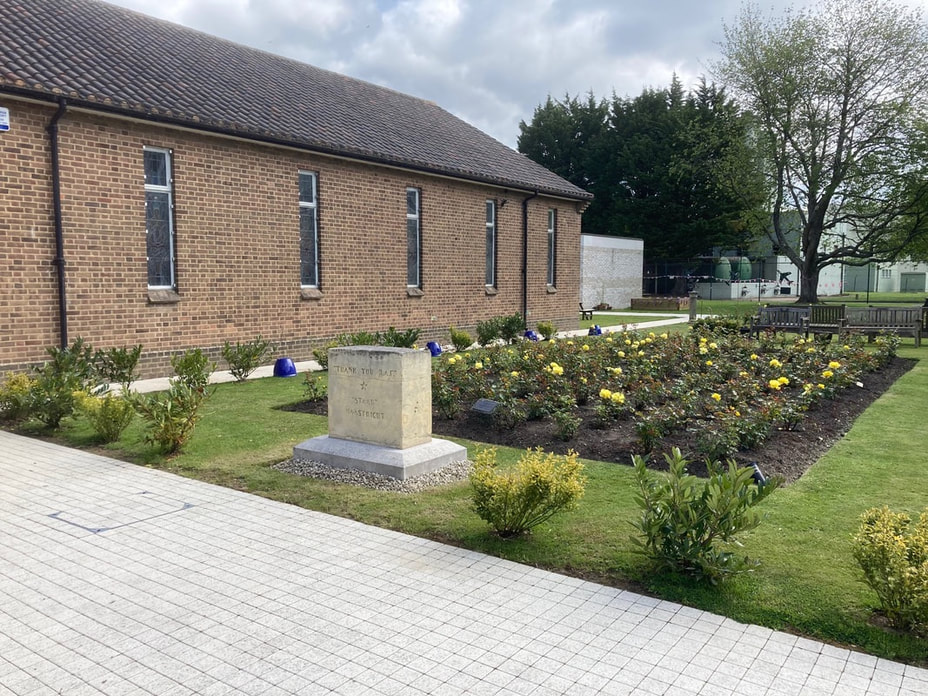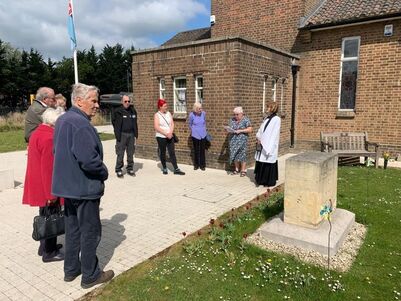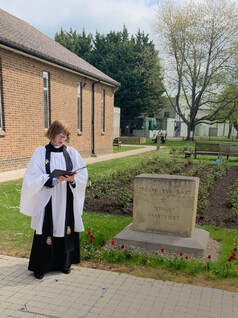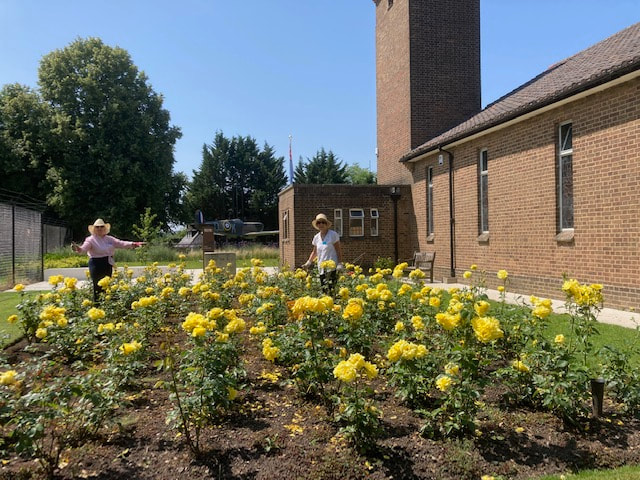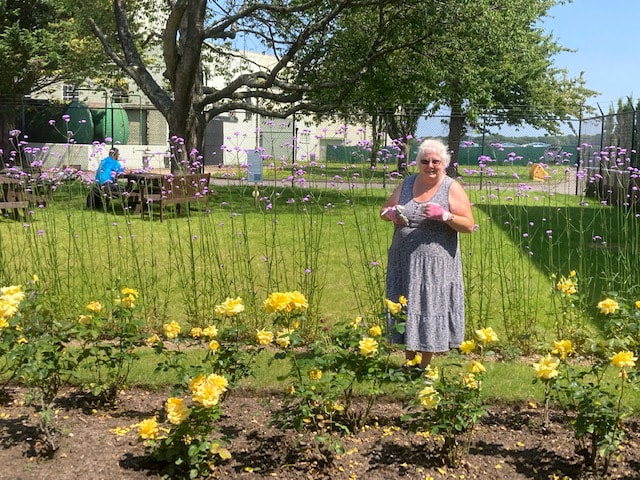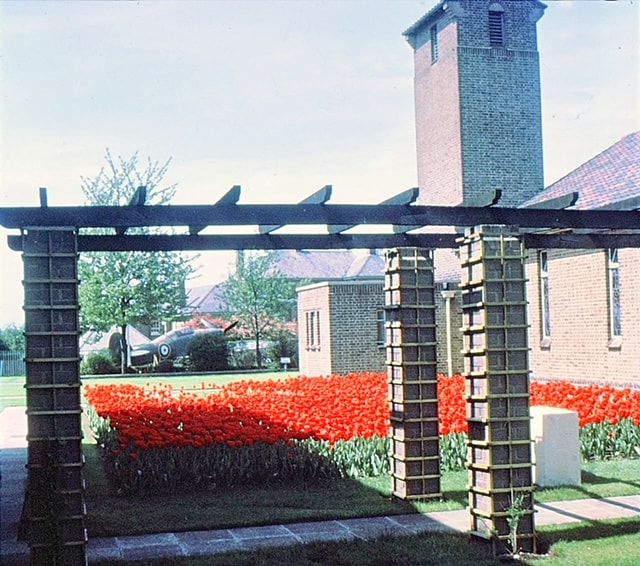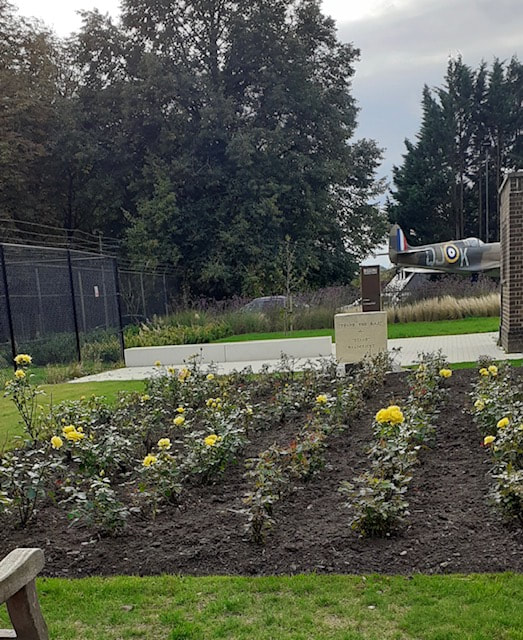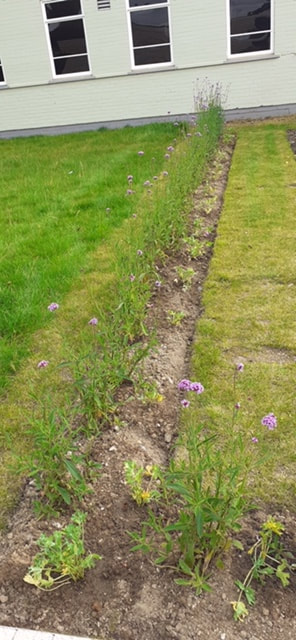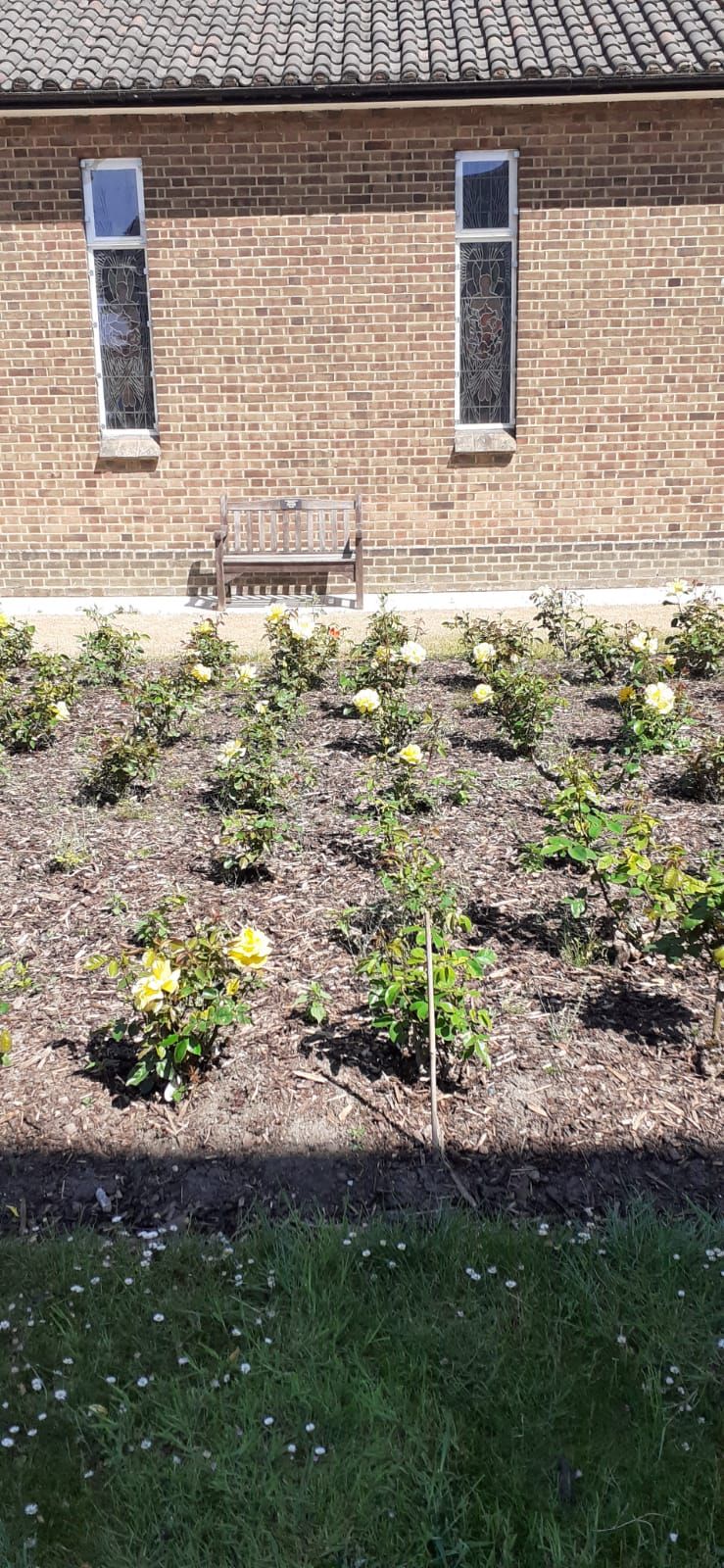|
25 th May 2024 The roses in the Remembrance Garden are starting to bloom and soon they will produce a lovely fragrance, often commented on by visitors. The roses are growing very well, but so are the weeds!! Help is needed. Where is it? Where are you ? Even an hour with the hoe, can make a difference. The Wisteria has new life!!
Pieces of roots were dug up and replanted near two pillars of the pergola ..... it has taken time but they survived and are sprouting! |
|
June 2022
Work is progressing well with the planting of bushes along the side of the path next to the Chapel. This is being done to show that the Garden enclosed is special, and we hope it will prevent people from simply wandering through on their way to the café.
The Blessing of the Maastrict Stone
On the 5th May a small service took place lead by Reverend Alison Newman, who blessed the Maastrict Stone. The Maastrict Stone was presented by the Dutch people, in thanksgiving for the help the Royal Air Force gave to the Dutch Resistance in WWll.
It was moved to its present place, during the building works in 2018 and on consecrated ground. The date chosen for the blessing was the anniversary of the Liberation of Holland, the day after Remembrance Day in Holland.
On the 5th May a small service took place lead by Reverend Alison Newman, who blessed the Maastrict Stone. The Maastrict Stone was presented by the Dutch people, in thanksgiving for the help the Royal Air Force gave to the Dutch Resistance in WWll.
It was moved to its present place, during the building works in 2018 and on consecrated ground. The date chosen for the blessing was the anniversary of the Liberation of Holland, the day after Remembrance Day in Holland.
On a very hot day, (2021)FSGC volunteers deadheaded the roses in preparation of the 70th Anniversary Service of the Chapel. One lady had travelled from Guildford!
Small red tulips were planted and bloomed this year around 2021 the Maastricht Stone.
The Stone was moved in 2018 to the front of the garden.
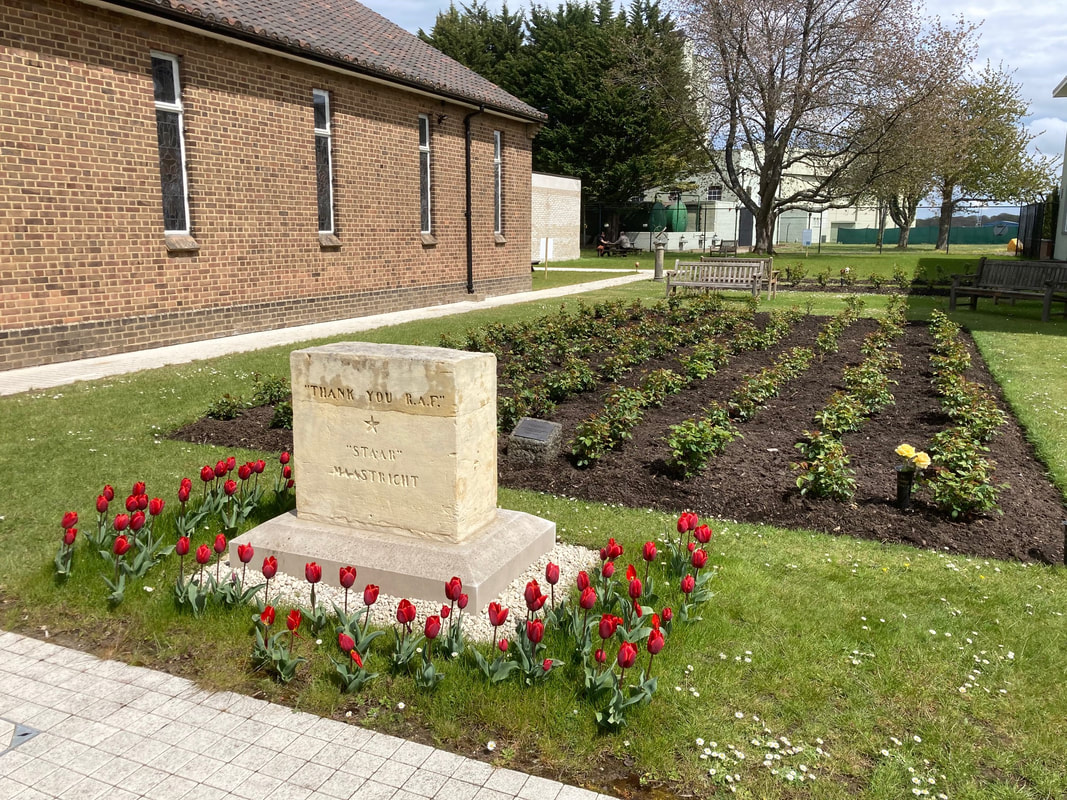
.
.
.
Red tulips once filled the Garden of Remembrance, given by the Netherlands.
MAASTRICHT STONE in the GARDEN of REMEMBRANCE
The Maastricht Stone
12th May 1940; a salvo of bombs burst on the German troops massed on the East Bank of the river Meuse at Maastricht, Netherlands, during the desperate attempt by aircraft of No. 2 Group RAF, to block the German advance by bombing bridges and buildings near the bridges in Maastricht, Hassett and Tongres. Of the 42 Bristol Blenheims despatched on the raids by RAF Squadrons 15, 107 and 110, eleven were shot down.
On 29th April 1945 the RAF launched Operation Manna to deliver food and supplies to the starving Dutch people. The mission was launched in the last days of the Second World War after German occupation and had left the country without food or provisions. It was originally planned for 28th April but delayed by the Germans who had agreed, through the Red Cross, to allow planes to drop food in a ‘window’ of one hour.
In 1968 the Maastricht Stone in the Garden of Remembrance was flown in by the RAF and a series of concerts were given in the Royal Albert Hall and Westminster Abbey by the famous local choir, The Mastreechter Staar, to mark the occasion. A dedication service was held at in St. George’s RAF Chapel, Biggin Hill.
The stone is a simple block of local limestone from Maastricht, with the words ‘THANK YOU RAF. MAASTRICHT STAAR.’ engraved on its face and for 50 years had stood looking over the Garden from in front of the pergola, which is no longer in the Garden. At the time of its presentation, the Garden was a massed bed of red tulips, also given by the people of the Netherlands.
The Garden is now consecrated, with the ashes interred there of those who have served in the Royal Air Force, their spouses or have been a member of the Chapel congregation, . The red tulips have been replaced by yellow roses called ‘Koresia’.
In 2018 the stone was refurbished through heritage lottery grant, an extra engraving was added to the reverse of the stone and it was moved to a new position in front of the Garden.
This year, 2021, 70 red tulip bulbs planted in 2020, have flowered round 3 sides of the stone, to commemorate the 70th. Anniversary of the Dedication of the present day Chapel and to recall the presentation of the Stone in front of the bed of tulips.
Documentation that is available has not clarified why Biggin Hill RAF Station was chosen to receive the Stone. The Squadrons involved in both events did not fly from Biggin Hill Station at those times.
‘THANK YOU RAF’ undoubtedly reflected the help that the RAF gave to the Dutch people in both events.
If anyone has more information about the Stone and its chosen place, do please let us know so that we can continue to update information. Thank you.
The Maastricht Stone
12th May 1940; a salvo of bombs burst on the German troops massed on the East Bank of the river Meuse at Maastricht, Netherlands, during the desperate attempt by aircraft of No. 2 Group RAF, to block the German advance by bombing bridges and buildings near the bridges in Maastricht, Hassett and Tongres. Of the 42 Bristol Blenheims despatched on the raids by RAF Squadrons 15, 107 and 110, eleven were shot down.
On 29th April 1945 the RAF launched Operation Manna to deliver food and supplies to the starving Dutch people. The mission was launched in the last days of the Second World War after German occupation and had left the country without food or provisions. It was originally planned for 28th April but delayed by the Germans who had agreed, through the Red Cross, to allow planes to drop food in a ‘window’ of one hour.
In 1968 the Maastricht Stone in the Garden of Remembrance was flown in by the RAF and a series of concerts were given in the Royal Albert Hall and Westminster Abbey by the famous local choir, The Mastreechter Staar, to mark the occasion. A dedication service was held at in St. George’s RAF Chapel, Biggin Hill.
The stone is a simple block of local limestone from Maastricht, with the words ‘THANK YOU RAF. MAASTRICHT STAAR.’ engraved on its face and for 50 years had stood looking over the Garden from in front of the pergola, which is no longer in the Garden. At the time of its presentation, the Garden was a massed bed of red tulips, also given by the people of the Netherlands.
The Garden is now consecrated, with the ashes interred there of those who have served in the Royal Air Force, their spouses or have been a member of the Chapel congregation, . The red tulips have been replaced by yellow roses called ‘Koresia’.
In 2018 the stone was refurbished through heritage lottery grant, an extra engraving was added to the reverse of the stone and it was moved to a new position in front of the Garden.
This year, 2021, 70 red tulip bulbs planted in 2020, have flowered round 3 sides of the stone, to commemorate the 70th. Anniversary of the Dedication of the present day Chapel and to recall the presentation of the Stone in front of the bed of tulips.
Documentation that is available has not clarified why Biggin Hill RAF Station was chosen to receive the Stone. The Squadrons involved in both events did not fly from Biggin Hill Station at those times.
‘THANK YOU RAF’ undoubtedly reflected the help that the RAF gave to the Dutch people in both events.
If anyone has more information about the Stone and its chosen place, do please let us know so that we can continue to update information. Thank you.
9th May 21 Red tulips once filled the Garden of Remembrance, given by the Netherlands.
Red tulips were planted and bloomed this year around the Maastricht Stone.
Remembrance Garden March - May 2020
The Remembrance Garden and the whole site is closed to the public in line with Government rulings.
The Garden, however, is being cared for by The Friends of St George's Chapel. The roses are blooming well despite the lack of rain for well over two months. Watering has been infrequent because of the restrictions and the installation of an automatic watering system is being considered.
The Garden, however, is being cared for by The Friends of St George's Chapel. The roses are blooming well despite the lack of rain for well over two months. Watering has been infrequent because of the restrictions and the installation of an automatic watering system is being considered.
The Remembrance Garden on 30th May 2020
All work done in the Remembrance Garden is by volunteers.
If you would like to help, please contact us by clicking on - [email protected]
If you would like to help, please contact us by clicking on - [email protected]
Burial of Ashes
Ashes can be buried in the Garden of Remembrance. ( Certain criteria applies - see Guidelines in Services).
When ashes are buried, the family is given a copy of the burial plot giving the plot number, a copy of the words recorded in the Book of Remembrance and any photographs that they have asked to be taken.
A membership form for the Friends is included. Although the Remembrance Garden is cared for and maintained by volunteers, members' subscriptions help fund the necessary purchases for the upkeep of the roses, grass and the Remembrance Garden generally.
When ashes are buried, the family is given a copy of the burial plot giving the plot number, a copy of the words recorded in the Book of Remembrance and any photographs that they have asked to be taken.
A membership form for the Friends is included. Although the Remembrance Garden is cared for and maintained by volunteers, members' subscriptions help fund the necessary purchases for the upkeep of the roses, grass and the Remembrance Garden generally.







